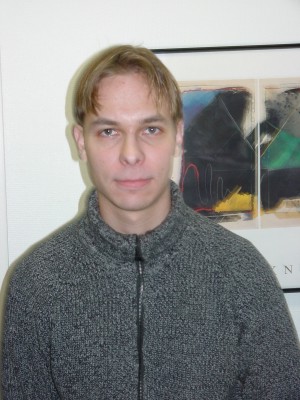Third Medical
Physics and Medical Engineering Day
| ||||
|
In many species vision acts as the main source for receiving information from the surrounding world and can therefore be thought of as a highly optimised system for collecting and processing information. Insect photoreceptors have provided a model system for examining specific molecular mechanisms involved in information processing with voltage signals. These include ion channels, which act as a fundamental element in electrical signaling. In this study we wanted to clarify the role of prototypical inactivating K+-channel, Shaker, in information capacity of Drosophila photoreceptors. As methods we used a combination of experimental work and modeling. Patch-clamp method was used for defining voltage-dependent properties of ion channels. Intracellular recordings were performed in vivo to obtain other biophysical properties of photoreceptors. Versatile experimental data allowed deriving Hodgkin-Huxley type model with small number of free parameters. Intracellular recordings showed that the loss of the Shaker K+-conductance produces a dramatic reduction in the signal-to-noise ratio of photoreceptors generating a 50% drop in the information capacity of these cells. The model was used to show that the inactivation of Shaker K+-channels amplifies voltage signals and enables photoreceptors to use their available voltage range more effectively. This mechanism can explain only part of the observed reduction in information capacity. Experiments also show a drop in impedance following from the loss of the Shaker, which could be explained by using the model with the compensatory increase in leak conductances. Simulations suggest that this increase in leak enables optimised compensation for the compression and saturation of the responses. By combining these two findings, this study demonstrates the importance of the Shaker K+-conductance for neural coding precision and as a mechanism for selectively amplifying graded signals in neurons and also highlights the effect of compensatory mechanisms upon neuronal information processing. |
 |
|||
Teppo Stenholm,
University of Turku
| ||||
|
TPX-measurement device is a two-photon excitation microfluorometer for multiplexed single-step bioaffinity assays. It is well suited for use in routine clinical diagnostics, for example in measurement of CRP-levels as a predictive factor for myocardial infarction. The TPX also meets the demand for a cost-effective high throughput screening method. The important factors for cost reduction are simplification of assay protocols and reduction in use of consumables, such as coated tubes. Ultrafast lasers are ideal where high peak powers or ultrafast probing is required and therefore they have been utilized in most applications of two-photon excitation. Unfortunately ultrafast lasers are very expensive and bulky systems. In TPX longer pulse durations are sufficient and therefore low-cost near-infrared microchip lasers can be used, an essential condition for the application to spread outside research laboratories. Pulse widths vary considerably among individual microchip lasers of the same type and therefore an effective tool for their characterization was found necessary. Standard oscilloscopes and photodiodes can be used to directly measure time domain intensity profiles of nanosecond pulses. Expensive ultrafast devices, such as streak cameras, can extend the range of direct measurements to tens of picoseconds. Indirect methods do not require ultrafast detection and so they can be applied to measurement of even shorter pulse widths. The traditional indirect method, an intensity autocorrelator, has some disadvantages. It provides very little information on pulse shape and cannot detect pulse-to-pulse variations. Several new indirect methods have been developed to overcome these problems, but their range of measurement is unfortunately limited to ultrafast pulses. As a cost-effective solution for measurement of pico- to nanosecond pulse widths, a long-arm (400 mm) intensity autocorrelator was built. The long arm intensity autocorrelator design was based on the Michelson interferometer. An optical delay path adjustable by 400 mm was included. Using back and forth reflections its physical length was reduced to only one-fourth of its optical length, making the autocorrelator manageable in size and allowing the use of a standard 100 mm translation stage. A collinear type I mixing of sub-beams in a SHG -crystal was chosen to increase signal level and to make the alignment process easier. Relatively long pulse durations of the microchip lasers allowed us to use a thick nonlinear crystal (LBO, 3mm), which provides an even higher SHG-signal and a better SNR. The generation efficiency of the SHG-crystal is strongly dependent on the direction of propagation and on the intensity of the generating beam. Two lenses were used to decrease the waist of the beam and so to increase the intensity without changing the angle of incidence with the crystal in any part of the beam. Autocorrelation measurements in general are notoriously difficult to set up and therefore the autocorrelator was specifically designed to make the alignment easier. A set up for a measurement of a new laser is a systematic procedure and typically a matter of several minutes. Maintaining the alignment while scanning the delay is also a common problem. The autocorrelator uses a retro-reflector to compensate for any non-idealities of the translation. The length of the delay path may be changed, but that is insignificant as we are measuring intensity autocorrelation. The autocorrelator was automatised using a PCI-MIO-16E-1 DAQ-card and LabVIEW 6.i software. The 400 mm optical delay path in combination with a least sum of squares fitting algorithm allows us to reliably measure pulse widths of up to several nanoseconds. The lower limit for the range of measurements is set to few picoseconds by the thickness of the crystal and the resolution of the translation stage. |
 |
|||
Kalle Koho,
University of Oulu
| ||||
|
In this work, the localization of a person walking on a pressure sensitive EMFi-floor was studied. Electromechanical film (EMFi) is a thin, permanently charged plastic film, coated on both sides with thin metal electrode layers. An external pressure affecting on the EMfi (for example a walkers footstep) can be detected as a voltage signal created by the film. The focus of this work was to develop signal processing methods to detect and localize the footsteps of a person walking on the EMFi-floor. The goal is to utilize the EMFi-floor in hospital environments or in old-age homes, where the EMFi-based system could monitor possible hazardous situations (for example if a patient falls in his room). When the system detects such hazardous event, it can automatically alarm a nurse about it and help can be provided as fast as possible. In our system the EMFi material is installed under the flooring of our research laboratory. The EMFi-layer under the flooring is constructed of 30 vertical and 34 horizontal EMFi-sensor stripes, 30 cm wide and about 10 meters long each. All of the 64 EMFi-signal channels were monitored for footstep signal profiles caused by person walking on the floor. A person moving on the floor was then located at the crossing of those EMFi-sensor stripes from which the footsteps were detected. The detection of these footstep patterns from EMFi-signals was implemented using two different methods. In the other method the EMFi-signals were preprocessed with FIR median hybrid filters, and then a simple edge detection method based on the calculation of signals first differential was used to detect rapid changes in the signal caused by walkers footsteps. The other method was based on statistical modelling of the footstep pattern. First a segmental semi-Markov model (SSMM) was built of an example footstep pattern, where each state corresponds to a linear segment in a piecewise linear approximation constructed from the example pattern. Then a Viterbi-like algorithm was used to detect similar patterns from the signals produced by the EMFi-sensor stripes. The implemented system was tested with footstep data collected from ten different persons. Each person walked a two minute period on the EMFi-floor, and the data was collected in a file. Both of the implemented footstep detectors worked well on the test data. Still the SSMM-based method was found better due to the fact that it included information about the shape of the footstep patterns into the detection procedure. This made the detector more accurate. The location accuracy of the EMFi-floor for one walker was 30 cm, which is obviously determined by the width of the sensor stripes. Achieved location accuracy was very good considering the possible application scenarios of the EMfi-floor. |
|
|||
Eero Väyrynen,
University of Oulu
|
||||
|
In addition to textual information, speech signal includes prosodic information such as intonation and speaking rate. This implicit information, which includes cues for example about persons affectual state can be accurately analysed for many speech processing applications. In this work, signal processing methods are developed for speech prosody calculation for the purpose of emotional speech content classification. Methods for automatic speaker independent global cepstrum and energy thresholding based voiced/unvoiced (V/UV) decision and time-domain F0 contour estimation were developed and implemented for the Matlab computing environment. More than 40 prosodic features were derived and automatically computed for the speech samples. These include mean, median, max, min, range, fractiles, derivatives and variance of F0 and RMS intensity. Also distributions, ratios, mean and max of silent, nonvoiced and voiced segment lengths and higher level prosodic parameters such as shimmer and jitter were calculated. An emotional speech corpus of Finnish was collected that includes hours of short emotional speech utterances spoken by professional actors in four basic emotional states (neutral, sad, angry and happy). Human listening tests were performed to verify emotional content and to form a base for comparison. The statistical method of forwards/backwards step search algorithm was applied in order to select an optimal prosodic parameter vector for the kNN classifier. Statistical classification experiments show that an average performance of 71.4% was achieved in the automatic recognition of emotional content of each utterance. For comparison a performance of 76.9% was achieved in the forced choice human listening tests. Classification results indicate that emotion recognition performance comparable to human listeners can be achieved using prosodic speech parameters. However it should be pointed out that the emotional content of our samples was relatively pure and intense: as professional actors produced the emotional speech material, effective vocal portrayals of emotions could be expected. The quality was not perfect, however, as only a range of 57-93% classification accuracy was achieved with human listeners. |
 |
|||